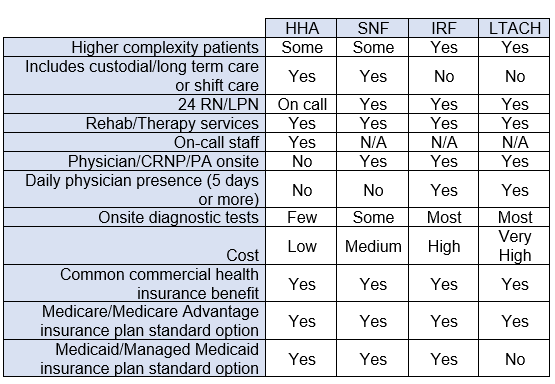
The use of post-acute care (PAC) is a topic that many of us are not ready for—even those of us who work in healthcare—but will face either for ourselves or a loved one. The goal of this two-part series is to help prepare you in the event that you need the services of a PAC provider. To help explore this topic, we have provided the following scenario:
Your elderly mother is completely independent, lives alone, still drives and has an active social life. You get a call one night from her, and she simply says, “Something is wrong.” You arrive at your mother’s home and determine that you immediately need to call 911.
Unfortunately, your mother is one of the 795,000 people who, according to the American Stroke Association, will experience a stroke this year. She is quickly admitted to the hospital. After a few days, your mother’s condition has stabilized, but she is unable to walk by herself and is having some memory problems. The hospital case manager approaches you to discuss her discharge plans as the team feels your mother is ready to move to the next level of care. This is a surprise to you since it was your understanding that she would stay in the hospital until she was ready to go home. This is a lot to take in and process for the both of you.
You’d hoped that after the hospital visit, she would be “back to normal” and return to her life as she was before this event. However, it is not safe for her to return home at this time because she still needs help walking and is still having memory issues. So you worry about the hospital discharging her, and whether she would ever get strong enough to return home, and what the next steps are for that to happen.
The case manager explains that your mother can continue to receive therapy and nursing care, but that it will be provided in a different setting. As the case manager discusses possibilities for the next level of care, including an inpatient rehabilitation facility (IRF), skilled nursing facility (SNF, also known as a nursing home), or home health agency (HHA), you realize that you really don’t know much, or anything, about these options. The hospital team provides you with a brief description of the different levels of PAC providers, but this is too much to process as you realize your mother needs to leave the hospital and for you to make some decisions.
You wonder if there was a way to learn more about these various care facilities to help you make a more informed decision. Because not only does the next level of care type need to be determined based on her medical needs, but you needed a list of choices for the appropriate provider type, so that the hospital could determine which of the PAC providers has both the ability to meet your mother’s care needs and the capacity to accept a new admission.
To better understand the different levels of PAC that are options for your mother, you review the information from the hospital and conduct an online search. One website with valuable information on PAC provider types and a list of providers in your geographic area is CMS’ Compare. Based on your research and the education from the hospital, you have determined the following:
- HHAs provides treatment for people in their own homes, with the goal of them becoming as self-sufficient as possible.
- SNFs are facilities for people who cannot be cared for at home due to more extensive care needs, including 24-hour nursing care.
- IRFs are facilities or units in a hospital that provide intensive rehabilitation or therapy services.
- Long-term care hospitals (LTACH) care for the critically ill and medically complex patients who require extended hospital care. Many LTACH patients are transferred to this setting after spending time in an intensive/critical care units in acute care hospitals.
There are other differences between these PAC providers, such as those indicated in the table below. The care facility that you choose for your mother would be determined by the specific care she needs, state regulations on what services the different provider types can offer, and her insurance benefits. It is important to note that some services she needs are not covered or are only partially covered by insurance, which means there would be out-of-pocket costs associated with these services.

The hospital team is recommending an IRF because of her prior level of function, her current abilities and her eventual goal to return home. Now you and your mother need to identify which IRF is your preference, based on the IRFs ability to meet her care needs and its capacity to accept a new admission. In parts of the country, your choice is limited due to the number of available PAC providers, and in other parts, there are multiple options in a geographic area. To make the best choice, you can use the information from the hospital, CMS Compare and your state Department of Health (DOH) website. It’s also recommended that you tour the facility to see firsthand how people are cared for by the staff.
At this point in her recovery, your mother is transferred to a local IRF. This is just the next step in her post-stroke journey.
Part two of this series will discuss additional care transitions, and the critical need for interoperability and accessibility of health information, both in acute care and across PAC providers.

